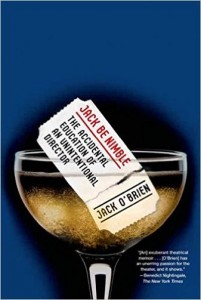At the risk of getting ahead of myself—or Jack O’Brien, for that matter—is Jack Be Nimble the first of three volumes? The present memoir chronicles O’Brien’s youth, education and apprenticeship in the theatre; we hear very little about his two decades running San Diego’s Old Globe Theatre, not to mention his many directing gigs on Broadway, which range from frothy musical hits (Hairspray) to epic history plays (The Coast of Utopia). Should we look forward to Jack Be Quick and Jack Jump Over the Candlestick in ensuing years?

That’s not a grumble; the persons and events recounted here, in bouncy, breathless prose, make for an amusing read. Anyone who has met O’Brien or seen him interviewed knows he is a juicy raconteur and well-rounded man of the theatre, a savvy commercial helmsman and steady hand on new plays. While he may not have the golden touch every time (neither he nor Katie Holmes could save Theresa Rebeck’s aptly titled Dead Accounts), O’Brien’s track record is varied and impressive. This season he staged the glittering world premiere of Douglas Carter Beane’s gay period drama, The Nance, and is expected to bring a musical version of Harry Houdini’s life to Broadway in 2014, starring Hugh Jackman.
Although O’Brien’s dreams (initially, to be a lyricist) were always firmly set on the Great White Way, there was no guarantee he’d get there. Raised middle-class in the Midwest, he attended the University of Michigan at Ann Arbor and drifted naturally into theatre. As a closeted gay man of the 1950s and a dab hand at the piano, it was hardly a surprising transition. Still, O’Brien affectionately charts the academic colleagues who helped him up the ladder toward a professional career—where his destiny was, for a period, intertwined with that of the Association of Producing Artists, led by the dashing Ellis Rabb.
While the narrative is propelled by O’Brien’s personal odyssey, Jack Be Nimble is also a firsthand history of America’s postwar regional theatre movement. Jump-started by impresario Tyrone Guthrie, the search for a sustainable repertory model beyond Broadway led to the formation of companies and venues from Connecticut to San Francisco. Taking up the gauntlet thrown by Guthrie, Rabb and a circle of actors—including Rabb’s wife, Rosemary Harris—created the APA. A residency at UMich led to Off-Broadway engagements, a partnership with T. Edward Hambleton and eventually a residency at the Lyceum Theatre, where the APA-Phoenix Repertory Company presented an astonishing run of classics in 1968 and ’69, staging Kaufman and Hart, Shakespeare, Eliot, Pirandello, Molière and others. O’Brien assistant-directed on several productions.
The lodestar and catalyst for O’Brien’s career, Rabb comes across almost like a figure out of Beardsley—a willowy, egotistical, mercurial actor-manager who held the APA together for its brief life through good taste, talent and sheer charisma. O’Brien had a front-row seat to his mentor’s many moods, from languid aesthete to enraged diva, not to mention an uncomfortably close view of Rabb and Harris’s very complicated marriage. In the book’s most intimate and harrowing scene, O’Brien must calm down a hysterical Harris in an isolated cabin—a scene shot through with the sense that she must have known on some level that her husband of 10 years was probably gay.
All these backstage and spotlight histrionics are rendered in vivacious, eloquent, irrepressibly chatty prose. O’Brien doesn’t dwell on directing technique or the minutiae of running a company, but he captures something more valuable: a true portrait of the artistic temperament, the spirit of repertory. The metaphor he uses to describe his strange, eventful journey from the APA to San Diego and back to Broadway is the pinball. Life’s vicissitudes and its surprise jolts have bounced him across the country many times. While O’Brien may portray himself as the passive, shiny orb, he actually proves to be a master player.
David Cote, theatre editor of Time Out New York and an early-career playwright and librettist.

